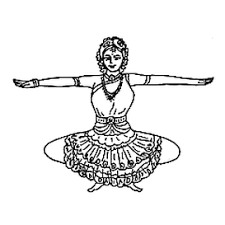
Bharatanatyam is a classical dance form that originated in South India and is known for its intricate footwork, graceful movements, and expressive gestures. One of the key elements of Bharatanatyam is the use of postures or positions, which form the basis of the dance form. One of these postures is the Muzhu Mandi, which is a sitting down posture that is used in Bharatanatyam.
What is Muzhu Mandi?
Muzhu Mandi is a sitting down posture that is used in Bharatanatyam. The word “Muzhu” means full, and “Mandi” means sit. The word Muzhu Mandi means full sit. In this posture, the dancer sits down with their knees spread apart as low as possible. The heels are elevated while the toes are pointing in opposite directions. The feet are placed in a straight line, and the back is kept straight.
Importance of Muzhu Mandi in Bharatanatyam
Muzhu Mandi is an important posture in Bharatanatyam, and it is used in many dance movements and sequences. It is a static posture that requires a lot of strength and balance, and it is essential for maintaining stability and control during complex footwork and movements. The Muzhu Mandi posture also helps to create a sense of grace and fluidity in the dance form, and it is an important aspect of the visual appeal of Bharatanatyam.
How to Execute Muzhu Mandi Properly
Executing the Muzhu Mandi posture properly requires a lot of practice and attention to detail. Here are some tips to help you execute the Muzhu Mandi posture correctly:
- Start with the feet: Begin by standing with your feet together and then turn them outwards at a 180-degree angle. Make sure that your weight is evenly distributed on both feet, and that your toes are pointing outwards.
- Bend the knees: Slowly bend your knees outwards to the sides, making sure that your thighs are parallel to the ground. Keep your back straight and your shoulders relaxed.
- Spread the knees apart: Spread your knees apart as far as possible, while keeping your feet in a straight line. Make sure that your heels are elevated while your toes are pointing in opposite directions.
- Maintain balance: To maintain balance in the Muzhu Mandi posture, make sure that your weight is evenly distributed on both feet, and that your thighs are parallel to the ground. Keep your back straight and your shoulders relaxed.
- Practice regularly: The Muzhu Mandi posture requires a lot of strength and flexibility, so it is important to practice regularly to improve your technique and maintain your form.
Conclusion
Muzhu Mandi is an essential element of Bharatanatyam, and it requires a lot of practice and attention to detail to execute properly. By spreading the knees apart as low as possible and elevating the heels while keeping the toes pointing in opposite directions, dancers can create a stable and aesthetically pleasing posture that is both graceful and fluid. With regular practice and dedication, anyone can master the art of Muzhu Mandi and unlock the full potential of Bharatanatyam.
